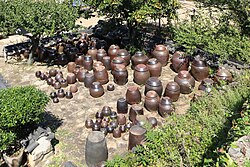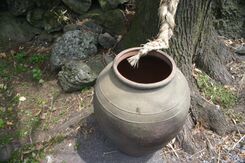Engineering:Onggi
| Onggi | |
 |
Onggi (Korean: 옹기; Hanja: 甕器) is earthenware extensively used as tableware and storage containers in Korea. It includes both unglazed earthenware, fired near 600 to 700°C, and pottery with a dark brown glaze fired at over 1100 °C.[1] Onggi have been used continuously since prehistoric Korean states until modern day; however, they primarily see use as traditional storage and ornaments today.

The origin of onggi dates to around 4000 to 5000 BCE.[3] The types of earthenware include patternless, mumun, and a red and black variety. The patternless earthenware is made with lumps of clay and fine sand. The predecessor of Goryeo celadon and Joseon white porcelain, the black/red earthenware excludes any sand in its creation process. The earthenware's color is determined by both the iron content of the clay and the method used to fire it. The modern onggi shape dates back from the Joseon era.
History
Pottery has been used on the Korean peninsula since prehistoric times for food storage. In the Three Kingdoms period, images of large and small pottery appear on the murals of Anak Tomb No. 3 in Goguryeo, and in Baekje, and Silla. Records indicate that they were used to store rice, liquor, oil, soy sauce, and salted fish. Onggi was also commonly used to preserve drinking water. According to Gyeongguk daejeon, during the early Joseon period, there were 104 onggi craftspeople (옹장) in fourteen institutions, including Bongeunsa.[4]
Many records about onggi are found in Sejong Sillok Jiriji (세종실록지리지, "King Sejong's Treatise on Geography"), which includes further details about Korean pottery: "There are three kilns that make the yellow onggi in Chogye-gun and Jinju-mok, Gyeongsang Province".[5]
Korea has long been known for its fermented foods made in onggi. A passage from the Records of the Three Kingdoms reads: "Goguryeo people have a custom of making fermented foods".[6]
Uses
Onggi has a more microporous structure than porcelain. This feature facilitates fermentation of food. Food commonly made in onggi includes gochujang, doenjang, kimchi, and soy sauce. With proper porosity and permeability, onggi can give an optimally ripe quality to fermented foods. Fine-tuned onggi containers are highly suitable for various kinds of fermented products.[7]
The abundance of soybeans, which grow naturally in Korea, fresh resources from the sea surrounding the Korean Peninsula, and a proper climate for microbial development all play a significant factor in the importance and usage of fermentation for food processing. The development and refinement of onggi ware contributed to the development of fermented dishes in Korean cuisine. Large onggi ware were typically stored on a jangdokdae, an elevated floor near the house.[8]
Features
Onggi are made by a specialized group of workmen called onggijang (Korean: 옹기장). The design of the pots is influenced by the characteristics and climate of the regions in which they are made. As a result, the shape, size, and manufacturing method of onggi vary from region to region.[9] Nevertheless, onggi types share similarities: biodegradability, porosity, resistance to rot, as well as firmness or "vertebration".[10] Due to the low firing temperatures often used in producing onggi, they are archaeologically rarely found as the shards eventually return to its former clay state or are used as grog. Features of onggi include its breathability, stability, suitability for fermentation, economical price, porosity, and diverse usage.[11]
When heated to high temperature, the wall of the pottery vessel discharges the crystal water[clarification needed] it contains, generating pores that allow the air to flow between the inside and the outside. For this reason, onggi has been recognized as a breathable vessel from an ancient period of time.[12]
Suitability for fermentation
The most significant characteristic of Korean cuisine is its use of fermented food, utilizing onggi pots for the fermentation process. Other foods and items can also be stored in containers originally meant for fermentation, such as tobacco, candlesticks, and cooked rice.[13]
Since the materials to make onggi can be easily and cheaply obtained, onggi has traditionally retailed at a low price, making it obtainable for the lower and middle class.
Porosity
Before firing, the onggijang (onggi craftsperson) glazes its surface. This glaze plays a key role in providing a waterproof surface and preventing leaks. Afterwards, a large amount of sand particles are added to the body of the clay, acting as passages for air. This way, air but not water can pass through the pottery. Koreans describe this phenomenon as "onggi breathing". This property contributes to its widespread use in making fermented foods.[14][15]
Variety of usage
While onggi are mainly used as food containers, they can also be used to store household appliances such as lamps, fireplaces, ashtrays, coins, and ink pads, as well as ceremonial instruments and percussion instruments such as cans, onion jugs, and wind instruments.[16][17]
Production method
Onggi pots are made of clay that contains a high percentage of iron. First, the soil to make the pottery is put into the water and whipped out to remove sand and impurities. Once the water is removed from the resulting fine sediment, it is formed into a bowl which is then dried out in the sun. The potter dries the dried-up bowl again in the sun, washes it with a lye solution, then dries it again. The glaze that is applied to the bowl is mixed with various substances before being sifted through a sieve. After the glaze is applied to the bowl, an orchid or grass pattern is drawn on the body and the pot is air-dried thoroughly, baked in a kiln, and finished.[18]
Another process of making onggi is to first knead the soil, dry it in the shade, cut it with a tool to form a brick shape, and then smack it on the ground into a plank shape. This is referred to as Panzhangjil (판장질). Afterwards, it is placed onto a wheel and ironed (batting) with a Ddukmae (떡매). The shape of the onggi is determined by the speed and hand movements of the wheel. Since the pottery culture seemed likely to disappear after the 1960s, due to the appearance of plastic and stainless steel bowls, the Ministry of Culture designated the onggi Human Cultural Property in May 1989. In 1990, onggijang (onggi craftsperson) was designated as Intangible Cultural Heritage No. 96.[19][20]
See also
- Chemistry:Earthenware – Nonvitreous pottery
- Place:Korea – Region in East Asia
References
- ↑ 이, 종호 (2004-07-09). "숨쉬는 그릇 옹기". 네이버 뉴스. https://news.naver.com/main/read.nhn?mode=LSD&mid=sec&sid1=117&oid=078&aid=0000002069.
- ↑ Sayers, 18
- ↑ Moon, 74-91
- ↑ 조, 정현 (1987). 《옹기소론(甕器小論)》. 이화여자대학교 미술대학.
- ↑ Lee and Chung, 16
- ↑ Lee and Chung, 100
- ↑ Changwon Jeonmun Daehak, 7, 39-64.
- ↑ 문, 소운 (2017-12-05). "김칫독". 경상일보. http://www.ksilbo.co.kr/news/articleView.html?idxno=622220#08fn.
- ↑ Jeong, 138
- ↑ Jeong, 132
- ↑ 이, 종근 (2014-01-06). "옹기의 수수함과 소박한 멋". 새전북신문. http://www.sjbnews.com/news/articleView.html?idxno=450774.
- ↑ 이, 윤기 (2018-07-12). "한국인들 지혜 놀라워...". news1뉴스. http://news1.kr/articles/?3369738.
- ↑ 문, 재원 (2018-12-12). "장독에 담긴 한국의 맛". UPI뉴스. http://www.upinews.kr/news/newsview.php?ncode=1065541608878244.
- ↑ 서, 진발 (2008-10-10). "옹기 발효기능 탁월". 연합뉴스. https://news.naver.com/main/read.nhn?mode=LSD&mid=sec&sid1=103&oid=001&aid=0002307719.
- ↑ 문, 소운 (2017-02-14). "옹기에 담긴 그림". http://www.ksilbo.co.kr/news/articleView.html?idxno=578399#08fn.
- ↑ Robert sayers and Ralph Rangler, Smithsonian Folklif (1987). 《The Korean Onggi potlei》. Washington D.C, Smithsonian lnstitute Press..
- ↑ 김, 종욱 (2018-10-15). "세월의흔적,옹기". 매일신문. http://news.imaeil.com/Life/2018101215232822585.
- ↑ 이, 성규 (2018-11-06). "옹기는 왜 배불뚝이일까". 뉴스로드. http://www.newsroad.co.kr/news/articleView.html?idxno=10424.
- ↑ 두산백과. "옹기(onggi)". https://terms.naver.com/entry.nhn?docId=1129150&cid=40942&categoryId=32154.
- ↑ 윤, 기득 (2018-07-09). "장인의 숨결을 찾아". 울산매일. http://www.iusm.co.kr/news/articleView.html?idxno=807260.
- Literature
- Changwon Jeonmun Daehak 창원전문대학 [Changwon College], "Balhyosikpumui pumjire michineun onggiui mulseongpyeongga" 발효식품의 품질에 미치는 옹기의 물성평가 [Property evaluation of onggi on the quality of fermented food]. Nongnimbu, 2004
- Jeong Byeongrak. 옹기와의대화 [Conversation with Onggi]. Dongkwang Publisher 동광출판사. 1998. OCLC 41132937.
- Lee Hoonseok and Chung Yangmo. Onggi. Daewonsa. 1993. OCLC 27170579.
- Moon Yongrin 문용린 and Oh Hyeonseok 오현석, "A study on the actual state of scarce resources and the extinctive process", Gyoyuk Gwahak Gisulbu 교육기술과학부. [Ministry of Education, Science and Technology], 2004
- Robert Sayers (1987). The Korean Onggi Potter. Smithsonian Institution Press. http://www.sil.si.edu/smithsoniancontributions/Folklife/pdf_lo/SCFS-0005.pdf.
External links
 |


